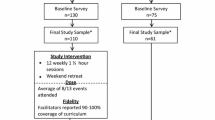Abstract
In a pilot study, young people in slums in Kampala, Uganda received an HIV prevention program (Street Smart) and were randomized to receive vocational training immediately (Immediate) or four months later (Delayed). Youth were monitored at recruitment, 4 months (85% retention), and 24 months (74% retention). Employment increased dramatically: Only 48% had ever been employed at recruitment, 86% were employed from months 21 to 24 post recruitment. Over two years, decreases were recorded in the number of sexual partners, mental health symptoms, delinquent acts, and drug use; condom use increased. Providing employment in low income countries, in conjunction with HIV prevention, may provide sustained support to young people to prevent HIV acquisition.
Resumen
En un estudio piloto, los jóvenes en los barrios bajos de Kampala, Uganda recibieron un programa de prevención del VIH (Street Smart) y fueron aleatorizados para recibir la formación profesional inmediatamente (inmediato) o cuatro meses más tarde (en diferido). La juventud fue vigilada en el reclutamiento, 4 meses (85% de retención), y 24 meses (74% de retención). El empleo aumentó dramáticamente: sólo el 48% había sido empleado en la contratación, el 86% fue empleado de 21 a 24 meses después de la contratación. Más de dos años, se registraron disminuciones en el número de parejas sexuales, los síntomas de la salud mental, los actos delictivos y el consumo de drogas; el uso del condón aumentó. La creación de empleo en los países de bajos ingresos, en conjunción con la prevención del VIH, puede proporcionar un apoyo sostenido a los jóvenes para prevenir la adquisición del VIH.

Similar content being viewed by others
References
UNAIDS, United Nations Program for HIV/AIDS. Report on the global AIDS epidemic. http://www.unaids.org/en/KnowledgeCentre/HIVData/GlobalReport/2008/2008_Global_report.asp(2008). Accessed 21 January 2009.
Michielsen K, Chersich MF, Luchters S, DeKoker P, VanRossem R, Temmerman M. Effectiveness of HIV prevention for youth in sub-Saharan Africa: systematic review and meta-analyses of randomized and non-randomized trials. AIDS. 2010;24(8):1193–202.
Dean HF, Fenton KA. Addressing social determinants of health in the prevention and control of HIV/AIDS, viral hepatitis, sexually transmitted infections, and tuberculosis. Public Health Rep. 2010;125(Suppl. 4):1–5.
World Bank. Africa Development Indicators 2008–2009, Youth Employment in Africa: The Potential, the Problem, The Promise. http://siteresources.worldbank.org/INSTATINAFR/Resources/ADI-200809-essay-EN.pdf (2009). Accessed 31 August 2010.
Ntozi JPM, Mulindwa IN, Ahimbisibwe F, Ayiga N, Odwee J. Has the HIV/AIDS epidemic changed sexual behavior of high risk groups in Uganda? Afr Health Sci. 2003;3(3):107–16.
Fox AM. The social determinants of HIV serostatus in sub-Saharan Africa: an inverse relationship between poverty and HIV? Pub Health Rep. 2010;125(Supplement 4):16–24.
Parker RG, Easton D, Klein CH. Structural barriers and facilitators in HIV prevention: a review of international research. AIDS. 2000;14(Supplement 1):S22–32.
McGrath JW, Rwabukwali CB, Schumann DA, et al. Anthropology and AIDS: the cultural context of sexual risk behavior among urban Baganda women in Kampala, Uganda. Soc Sci Med. 1993;36(4):429–39.
Denning P, DiNenno E. Communities in crisis: Is there a generalized HIV epidemic in impoverished urban areas of the United States? Abstract WEPDD101; XVIII International AIDS Conference, Vienna, Austria. July 18–23, 2010.
Gupta GR, Parkhurst JO, Ogden JA, Aggleton P, Mahal A. Structural approaches to HIV prevention. Lancet. 2008;372(9640):764–75.
Rotheram-Borus MJ, Koopman C, Haignere C, Davies M. Reducing HIV sexual risk behaviors among runaway adolescents. JAMA. 1991;266(9):1237–41.
Rotheram-Borus MJ, Song J, Gwadz M, Lee MB, Van Rossem R, Koopman C. Reductions in HIV risk among runaway youth. Prev Sci. 2003;4(3):179–88.
Lightfoot MA, Kasirye R, Comulada WS, Rotheram-Borus MJ. Efficacy of a culturally adapted intervention for youth living with HIV in Uganda. Prev Sci. 2007;8:271–3.
Derogatis LR, Melisaratos N. the brief symptom inventory: an introductory report. Psychol Med. 1983;13:595–605.
Holmes WC, Shea JA. Performance of a new, HIV/AIDS-targeted quality of life (HAT-QoL) instrument in asymptomatic seropositive individuals. Qual Life Res. 1997;6:561–71.
Sherbourne CD, Stewart AL. The MOS social support survey. Soc Sci Med. 1991;32:705–14.
The National Institute of Mental Health (NIMH) Multi-site HIV Prevention Trial Group. The NIMH Multisite HIV Prevention Trial: Reducing HIV sexual risk behavior. Science.1998;280:1889–94.
Author information
Authors and Affiliations
Corresponding author
Rights and permissions
About this article
Cite this article
Rotheram-Borus, M.J., Lightfoot, M., Kasirye, R. et al. Vocational Training with HIV Prevention for Ugandan Youth. AIDS Behav 16, 1133–1137 (2012). https://doi.org/10.1007/s10461-011-0007-y
Published:
Issue Date:
DOI: https://doi.org/10.1007/s10461-011-0007-y



